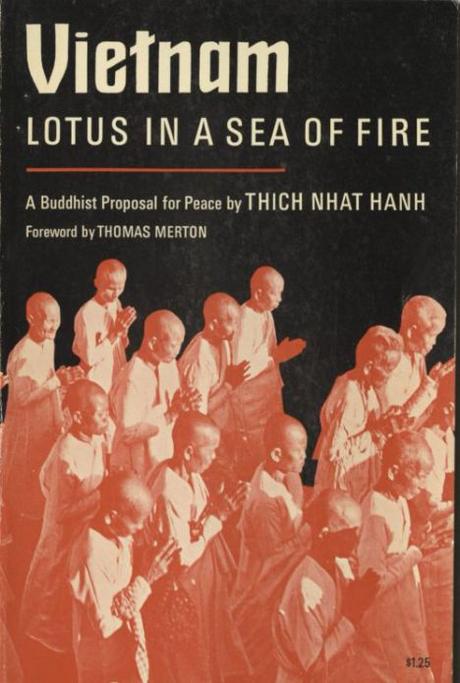
[Ed Note: This is the second of three Pauling-related posts authored by SCARC Student Archivist Ethan Heusser for the Rare@OSU blog, which explores the rare book collections held in the Oregon State University Libraries Special Collections and Archives Research Center.]
Though people often come to SCARC to access our collection of two-time Nobel laureate Linus Pauling’s documents and correspondence, an important but oft-overlooked part of the archive is his personal library. It contains an incredibly diverse amount of material, including history, fiction, science, psychology, drama, and activism. That last category is particularly important given Pauling’s shift toward peace and anti-nuclear activism in his mid-40s; a closer examination of the books in his library from that point onward offers a possible view of the mental landscape that gave his peace activism its sustained intensity.
One salient example is “Vietnam: Lotus in a Sea of Fire” by Buddhist monk and activist Thích Nhất Hạnh. Published in 1967, the book offers a piercing look into the real experience of Vietnamese people mid-crisis and how this commonly overlooked mindset contributed to the continually escalating Vietnam conflict.
It begins by discussing “the historical setting” of religion in Vietnam before quickly pivoting to the rise of communist-capitalist tensions as global powers began to get increasingly involved. Hanh uses this context to address inaccurate perceptions held by the American public about Vietnam’s cultural climate; for example, he demonstrates that the majority of NLF (National Liberation Front) soldiers were not in fact fighting for communism, but rather for the end of American occupation. In escalating the conflict for the sake of fighting communism, therefore, the U.S. occupying force only drove the people of Vietnam against it more.
Hanh also undermines the misconception that non-affiliated Vietnamese citizens helped the NLF because of coercion; rather, they assisted the NLF because of the promise of achieving national independence. (In his view, this perspective mainly developed due to the historical presence of French imperialism in Vietnam. He claims that people in Vietnam associate American presence with age-old French oppression, thereby carrying that anger and resentment directly over.)
“Vietnam: Lotus in a Sea of Fire” was published at a critical point in American history and in the history of the Vietnam conflict. It complicated the overly-simplistic narrative presented by American media, arguing that the best solution for Vietnam is a neutral one free from the control of both capitalist and communist superpowers. To Hanh, this neutral solution involves establishing an interim government truly representative of the people of Vietnam in order to conduct a free and fair election. He advocates for the emergence of engaged Buddhism as a necessary part of this change. (“Engaged Buddhism” was first coined by Hanh as a philosophy that asks Buddhists to use the principles of their faith to fight injustice and ameliorate inequity.)
There’s nothing out of the ordinary about the edition of “Vietnam: Lotus in a Sea of Fire” in our archives, but its presence in Pauling’s personal library can perhaps reveal some of the thoughts and ideas that inspired his anti-Vietnam War activism. Both Linus and Ava Pauling were strong public critics of the Johnson administration’s escalation in Vietnam – and books such as this make it easy to see why. Firsthand accounts from peace activists like Hanh make it difficult to interpret America’s role in the conflict as something other than immoral and ineffective.
It’s inaccurate to assume a person agrees with a book simply because it exists in one’s library – but taking this book in context of the tenor of Pauling’s larger collection as well as the vehement discourse he used in fighting for peace can perhaps shed some light on how the sharing of ideas from peace activists around the world allows for stronger resistance against global injustice.
Advertisements